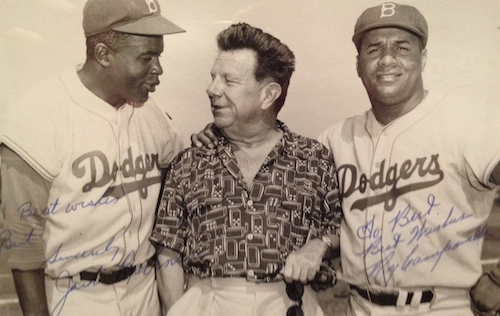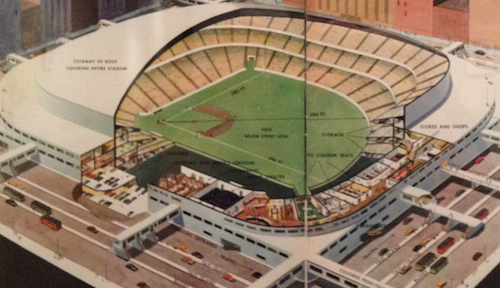
(Image credit: Harry Ransom Center)
The other day I was walking through the ongoing Norman Bel Geddes exhibition over at the Harry Ransom Center, and I spotted a photo of the designer with Jackie Robinson and Roy Campanella. You wouldn’t believe my surprise. What in the world were Robinson and Campanella doing with Bel Geddes? Up until that point in the gallery, I’d seen absolutely nothing having to do with baseball. And I didn’t think I would. Bel Geddes aesthetic preoccupation with what on the surface appears to be simply aerodynamics suggests a version of the future that we’re still trying to attain, like Ahab and his whale. Whether our cities will ever look like his remains to be seen. Perhaps I’m missing the point a bit, and maybe much of Bel Geddes’ work represents aesthetic advertisements rather than specific blueprints. But one can’t deny that Bel Geddes’ designs intently seek the immediate, the sleek, and the fashionable. These are all preoccupations inherently at odds with the boredom of baseball.
One of the reasons we love baseball is that it’s a pastoral break from the present. In many ways it’s completely contingent upon the past. The successes and failures of players are measured against the successes and failures of all who have come before. In its design it can be a vestige of Victorian oddity. It’s the only sport I can think of in which the defense possesses the ball. It’s a countryside recreation that’s most often played in cities. It’s doesn’t require a clock. And in the absence of countdown and a suggestion of veldt, baseball offers one time to think. Before and after each out players and fans have time to recollect or ponder, whether the game or not the game. And in these pauses baseball is boring when compared to modern electronic life. We have an aversion to silence in modern America, especially in public places. When, for instance, was the last time you went to a coffee shop and there wasn’t music playing?

(Image credit: Harry Ransom Center)
Bel Geddes was photographed with Robinson and Campanella because in 1949 he designed a new stadium for the Brooklyn Dodgers. The working title for this building was “All-Weather, All-Purpose Stadium,” although one’s got to think that had the project gone through this name would have been substituted for something a bit more intimate. Bel Geddes wanted the Dodgers to have a perfect park. No support posts obscured any views. The outfield wall was consistently 380 feet from home plate. The retractable roof could prevent rain delays. The artificial playing surface could negate a bad grounds crew. The shopping concourses were to contain entertainments for all sorts of fans. And maybe for these reasons I’m not sure if the stadium would have been the ideal park for modern fans. We like irregular outfield walls, real grass, cheap beer and O.K. food. I’d like to think of “All-Weather, All-Purpose Stadium” rather as an ideal entertainment venue. It was designed to seat 55,000 persons, but could make accommodations for as many as 90,000 if need be. Baseball parks only need to seat 45,000 max. As for the roof, I don’t mind a rain delay – such things just afford more time to think. At professional baseball games, music is played for certain concrete reasons (the Seventh Inning Stretch, for instance), and I wish I could report that Bel Geddes took this into consideration. More likely the case, however, the boredom of baseball might not have been apparent in 1949.


Recent comments
2 years 29 weeks ago
2 years 44 weeks ago
2 years 44 weeks ago
2 years 50 weeks ago
3 years 4 weeks ago
3 years 4 weeks ago
3 years 4 weeks ago
3 years 6 weeks ago
3 years 6 weeks ago
3 years 6 weeks ago